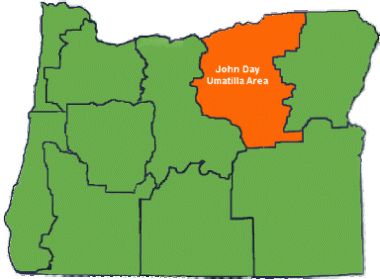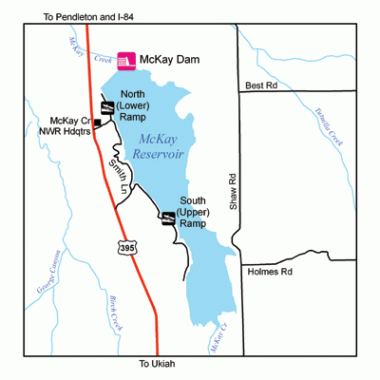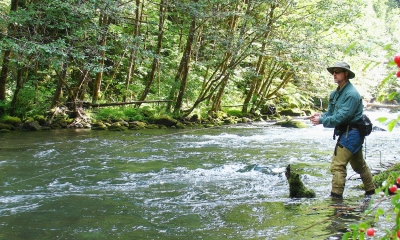
Warmwater fishing in John Day/Umatilla
The John Day – Umatilla area includes the John Day River and Umatilla River basins, and Oregon’s upper reaches of the Columbia River. The John Day Pool and McNary Pool of the Columbia offer outstanding fishing for bass and walleye, and many fishing tournaments are held here. Anglers also will find good fishing for bullhead catfish, crappie and other panfish in McKay Reservoir near Pendleton and Willow Creek Reservoir just outside of Heppner. For those who enjoy fishing for smallmouth, the John Day River offers one of the finest bass fisheries in the country and a unique opportunity for an extended river float trip through spectacular scenery.

Both novice and experienced anglers will be successful as the smallmouth are abundant and can be readily caught. Other warmwater fish found in this area include: Largemouth Bass | Smallmouth Bass | Bullheads | Black Crappie | White Crappie | Bluegill | Pumpkinseed | Yellow Perch | Warmouth | Channel Catfish | Walleye
Featured waterbody - McKay Reservoir
McKay is a 3-mile long reservoir located a few miles south of Pendleton and just east of Hwy 395. It is jointly managed by the Bureau of Reclamation and the McKay Creek National Wildlife Refuge to provide water for irrigation and habitat for a variety wildlife including osprey, bald eagles and an abundance of waterfowl. McKay’s shallow water marshes and wetlands are also productive for warmwater fish and support crappie, yellow perch, and brown bullhead catfish, and lesser numbers of largemouth and smallmouth bass.
Because McKay is managed for waterfowl, the reservoir is closed to fishing from October through February. During the rest of the year, it is open for day use only and camping is prohibited. For the boat angler, there are ramps on the north and south ends of the lake. However, water levels drop significantly in McKay during the summer and fall exposing extensive mud flats in the shallower southern half of the reservoir and along the shoreline. The north ramp located near the dam is usable for much longer than the south ramp. Access for the bank angler in spring is limited to the dam face and sites scattered along the reservoir’s western and southeastern shores. As the water drops, the amount of accessible shoreline increases as long as you’re willing to hike through the vegetation to get to the water.
When to fish
Fishing for bass and crappie is best during the spring, although fall when air and water temperatures begin to cool can also be good. Crappie fishing continues through the summer, but bass fishing slows down by mid-June after most of the bass have spawned. Evening is the best time to fish for crappie. Yellow perch and catfish are caught in McKay throughout the open season. Perch can be caught throughout the day, but catfish anglers will want to fish during the evening and night for best results.
Where to fish
Crappie
During the spring and early summer, crappie are generally caught in the upper (south) end of the reservoir, close to shore near cover provided by submerged cottonwood trees, water hyacinths, or other brush and wood, and along weed lines. As the water drops, fish in the evening off points or along the inundated willows lining the submerged McKay Creek channel. The creek channel can often provide good crappie fishing throughout the year.
Perch
Perch can be found just about anywhere in McKay, but are more common in the upper (south) end of the reservoir and off rocky banks with less brush than those where you would typically fish for crappie. In the lower (north) end of the reservoir, perch fishing is best along the dam face and nearby rock formations, and on the west side where the sloping bottom is shallower with broad flats.
Catfish
Fish for catfish in the southern end of the reservoir on the flats and along the submerged McKay Creek channel.
Bass
Largemouth are not common in McKay, but the reservoir occasionally produces big bass up to 8 pounds. During the spring, bass prefer the shoreline cover provided by submerged wood, brush, and cottonwood trees and can be difficult to fish for. As water levels drop, they’ll be found in deeper water along drop-offs and off the larger rocky points. McKay’s small number of smallmouth bass can also be caught in these same deep water areas.
Fishing techniques
Crappie
For crappie, use light spinning tackle rigged with 4-pound test line to fish a bobber and jig. Tie a small white, red and white, green and white, purple and white, or chartreuse plastic jig about 3 feet below the bobber. Cast the bobber and jig to water above or next to submerged willows or other cover. If you prefer to cast and retrieve lures, a small white or black and orange spinner also works well for crappie.
Catfish and perch
For perch or catfish, fish on the bottom using light or medium spinning tackle and 4- to 8-pound test line rigged with a slip-sinker and bait. Place the sliding sinker on the main line above the barrel swivel. Tie a 12- to 18-inch leader below the swivel and attach a hook baited with worms, or other panfish or catfish bait. Baits with a strong odor work best for catfish. The sliding sinker allows fish to take the bait before feeling the weight of the sinker.
Bass
Early in the season, and before the bass have spawned, fish with a jig, a tube, or black or purple rubber worms -- a deep, slow presentation is the key. Post-spawn bass can be caught on bigger and faster presentations using lures such as crankbaits and white spinnerbaits.



